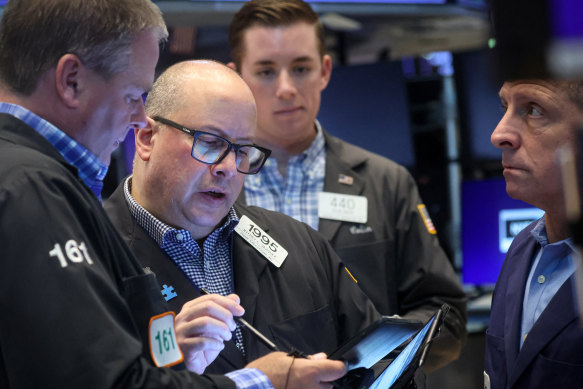US unemployment is at record lows and its economy has been growing at a respectable 2.3 per cent. Here employment is also near historical lows and the economy is growing at a similar rate to that of the US.
That suggests that it may be possible to manage this burst of inflation out of the system without the economic and social damage that the defeat of previous bouts of inflation, like “the recession we had to have” of the 1990s in Australia, have wrought.
It also suggests that this episode of inflation might be different to those of the relatively recent past.

The US is seeing signs that it is winning its war on inflation.Credit: Bloomberg
When inflation first started to develop momentum in the advanced economies during the first phase of the pandemic, the consensus among central bankers was that it would be a “transitory” phenomenon, one caused by the sudden and unforseeable disruption to supply chains that would end once the worst of the pandemic had passed.
What they misjudged was how severe and prolonged those disruptions would be, along with the effects of the massive injections of liquidity and cash into their economies from the central banks’ own actions and the unprecedented fiscal responses of their governments.
Loading
That meant they were slow to recognise the potential for inflation to get out of control. In the US, the headline rate peaked at 9.1 per cent just over a year ago. Here it peaked at 7.8 per cent last December.
While it took much longer than anticipated, global supply chains and the cost of accessing them have largely returned to pre-pandemic levels.
A significant influence over inflation rates during the past two years has, for instance, been the prices of cars, new and used.
The pandemic triggered reduced production in expectation of reduced demand and a dearth of the semiconductors essential for modern cars. That led to shortages and long waiting lists for new vehicles and a significant spike in the cost of used cars.
In the latest data, the prices of new cars flat-lined month-on-month and used car prices were down 0.5 per cent.
Another indicator of how far along the path towards pre-pandemic settings was provided by the industry that was arguably the most disrupted by the pandemic. Airfares in the US fell 8.1 per cent in June.
As we’ve seen in this market, the global aviation industry has gradually returned much of the capacity it mothballed during the pandemic.
Qantas’ domestic capacity is now back to pre-pandemic levels, for instance, and its international capacity is expected to be back to pre-pandemic levels by March next year. As the industry’s capacity increases prices will inevitably fall.
The Fed isn’t about to declare victory on the basis of one month’s figures but the US inflation rate has been falling, albeit slowly, for the past 12 months. While it will still probably raise the federal funds rate by another 25 basis points this month, beyond that it will start to consider whether further increases risk unnecessary economic damage.

Wall Street jumped on the newsCredit: Reuters
Among the central banks that moved earliest and most decisively was the Reserve Bank of New Zealand. This week it kept rates on hold (its cash rate is 5.5 per cent against our Reserve Bank’s 4.1 per cent) for the first time in two years, truncating a series of 12 consecutive increases.
New Zealand, which has been in technical recession (at least two consecutive quarters of economic contraction) since the December quarter last year may be the first of the central banks to end this cycle although, as is probably going to be the case with most of the central banks, interest rates are likely to remain at their peak, or terminal, levels until well into next year as the banks ensure that the hard-won gains are locked in.
The RBA’s much-maligned governor, Philip Lowe, who has tended to be more cautious than some of his more hawkish peers over the past year, indicated this week that further rate rises here might not be necessary. It remains to be determined, he said, whether monetary policy has more work to do.
Loading
Given the novelty of this inflation episode, the potential for unexpected developments in both directions given the brittleness and volatility of the global economic and geopolitical environments and the risk of monetary policy overkill at this late stage in the rate cycle, a cautious approach would appear the pragmatic and sensible approach at what may come to be regarded as the pivotal phase of this cycle.
The Business Briefing newsletter delivers major stories, exclusive coverage and expert opinion. Sign up to get it every weekday morning.
Stay connected with us on social media platform for instant update click here to join our Twitter, & Facebook
We are now on Telegram. Click here to join our channel (@TechiUpdate) and stay updated with the latest Technology headlines.
For all the latest Business News Click Here
For the latest news and updates, follow us on Google News.
